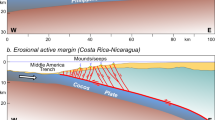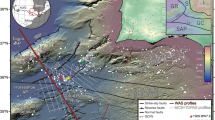Abstract
A re-analysis of the magnitude 6 earthquakes that occurred near Long Valley caldera in eastern California on 25 and 27 May 1980, suggests that at least two of them, including the largest, were probably caused by fluid injection along nearly vertical surfaces and not by slip on faults. Several investigators1,2 have reported difficulty in explaining both the long-period surface-wave amplitudes and phases and the locally recorded short-period body-wave first motions from these events, using conventional double-couple (shear fault) source models. They attributed this difficulty to: (1) complex sources, not representable by single-fault models; (2) artefacts of the analysis methods used; or (3) effects of wave propagation through hypothetical structures beneath the caldera. We show here that the data agree well with the predictions for a compensated linear-vector dipole (CLVD) equivalent-force system3 with its principal extensional axis horizontal and trending N 55–65° E. Such a mechanism is what would be expected for fluid injection into dykes striking N 25–35° W, which is the approximate strike of numerous normal faults in the area.
This is a preview of subscription content, access via your institution
Access options
Subscribe to this journal
Receive 51 print issues and online access
$199.00 per year
only $3.90 per issue
Buy this article
- Purchase on Springer Link
- Instant access to full article PDF
Prices may be subject to local taxes which are calculated during checkout
Similar content being viewed by others
References
Barker, J. S. & Langston, C. A. EOS 62, 958 (1981).
Given, J. W., Wallace, T. C. & Kanamori, Hiroo Bull. seismol. Soc. Am. 72, 1093–1109 (1982).
Knopoff, L. & Randall, M. J. J. geophys. Res. 75, 4957–4963 (1970).
Cockerham, R. S., Ryall, A. S. & Corbett, E. J. EOS 61, 1041 (1980).
Julian, B. R. Geophys. J. R. astr. Soc. (in the press)
Ishimoto, Mishio, Bull. Earthquake Res. Inst. 10, 449–471 (1932).
Aki, Keiiti, SIAM-AMS Proc. 12, 43–58 (1979).
Randall, M. J. & Knopoff, L. J. geophys. Res. 75, 4965–4976 (1970).
Aki, Keiiti & Richards, P. G. Quantitative Seismology (Freeman, San Francisco, 1980).
Savage, J. C. & Clark, M. M. Science 217, 531–533 (1982).
Author information
Authors and Affiliations
Rights and permissions
About this article
Cite this article
Julian, B. Evidence for dyke intrusion earthquake mechanisms near Long Valley caldera, California. Nature 303, 323–325 (1983). https://doi.org/10.1038/303323a0
Received:
Accepted:
Issue Date:
DOI: https://doi.org/10.1038/303323a0
This article is cited by
-
Stress field disruption allows gas-driven microdeformation in bentonite to be quantified
Scientific Reports (2024)
-
Resistivity and density modelling in the 1938 Kutcharo earthquake source area along a large caldera boundary
Earth, Planets and Space (2009)
-
Anomalous focal mechanisms: tensile crack formation on an accreting plate boundary
Nature (1984)
Comments
By submitting a comment you agree to abide by our Terms and Community Guidelines. If you find something abusive or that does not comply with our terms or guidelines please flag it as inappropriate.



